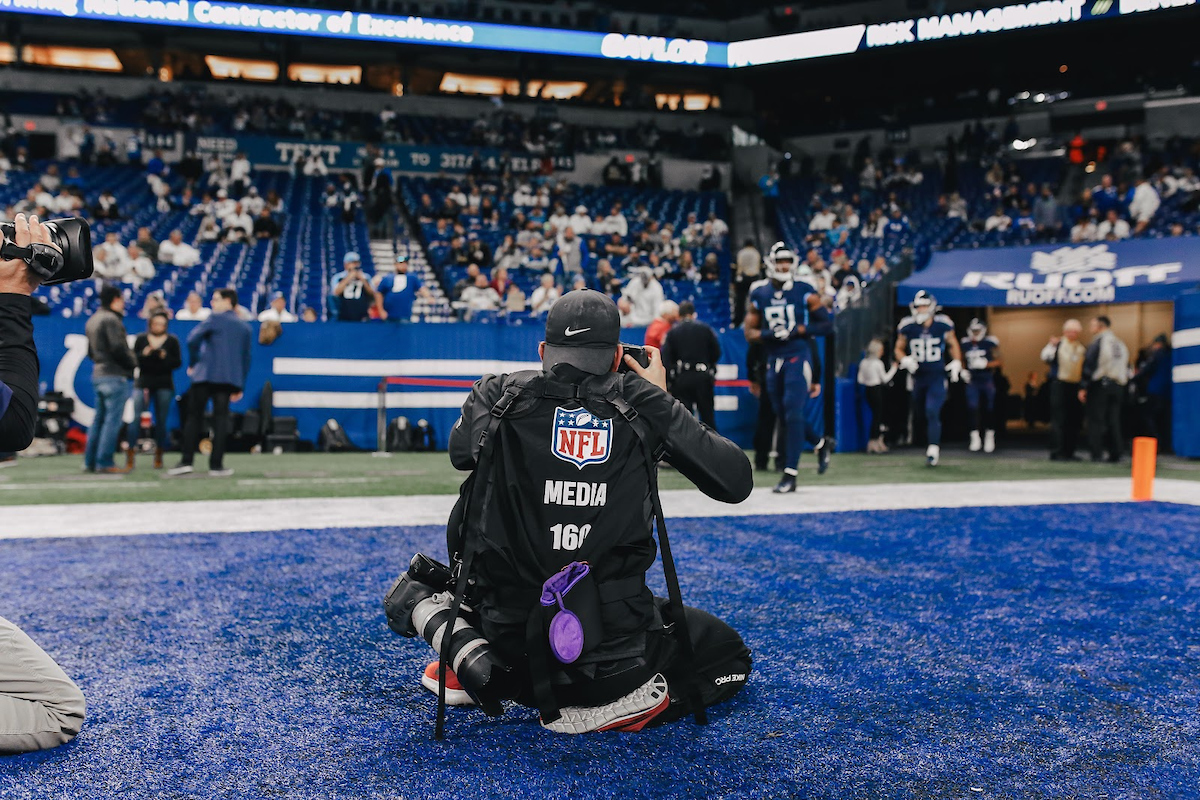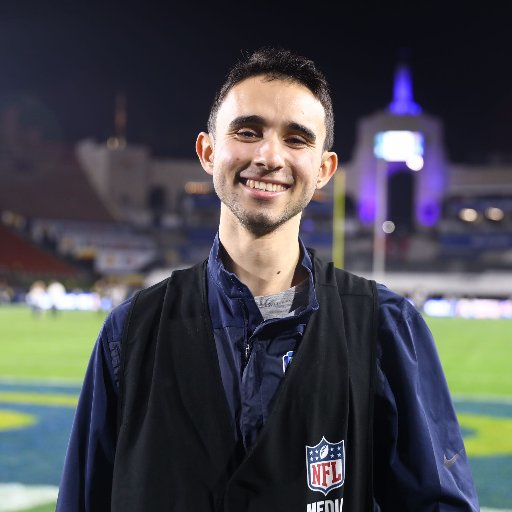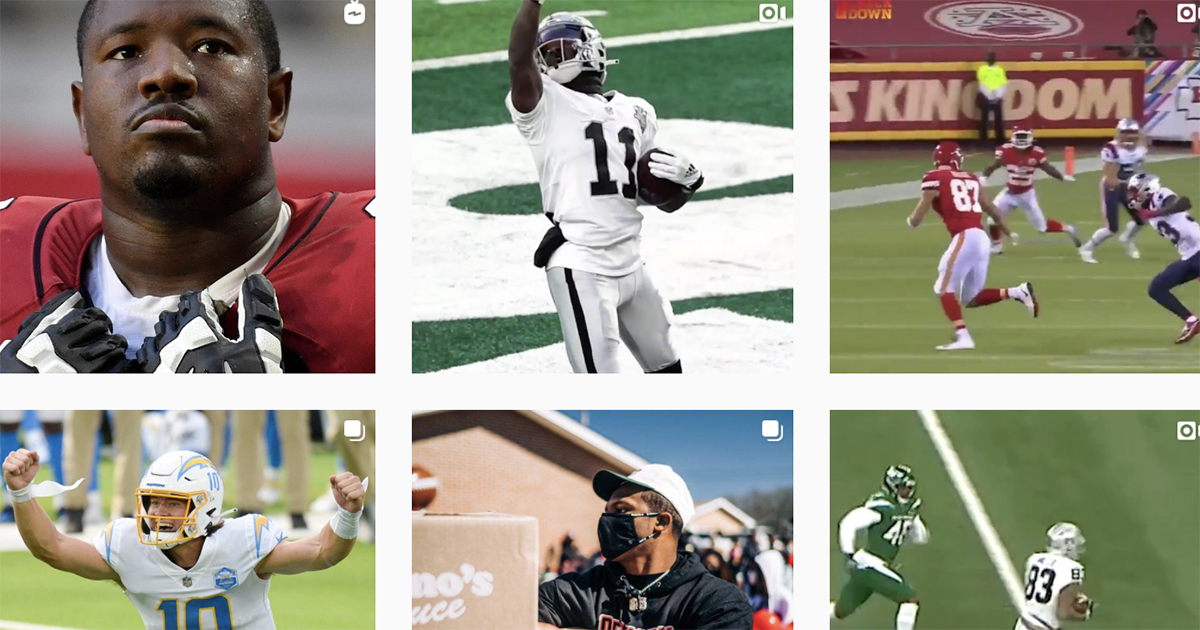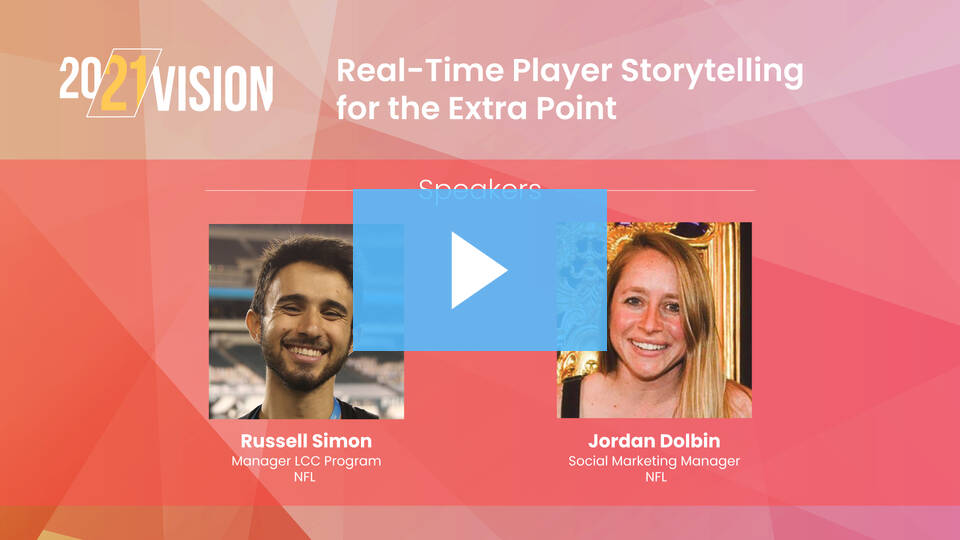Your favorite wide receiver scores a touchdown and celebrates with some new dance moves. Within seconds, a clip of that celebration is all over social media on your device.
How does that happen? The clip can’t be pulled from the live broadcast, can it? Does the NFL have its own separate cohort of content creators on the field of play, looking for those social media moments and uploading them immediately from the stadium after capture?
During this season’s playoffs, NFL Manager of Social Media Operations Russell Simon and NFL Social Marketing Manager Jordan Dolbin sat down with Kristin Twiford, Content Marketing Director for PhotoShelter for Brands, to discuss how the NFL’s social media team has, over four years, built a real-time workflow for every game day — not just to upload clips from the field of play but also to enable 900 NFL players to use those clips by the time they get back to their locker in the dressing room.

The discussion took place during “20/21 Vision – The Strategy Summit by PhotoShelter.” The NFL’s social media strategy is powered by two key factors: Live Content Correspondents (LCCs) and the Player Social Marketing Program.
“The Live Content Correspondent program is an always-on League-wide network of skilled content creators who capture and create content for NFL, clubs and players, 365 days a year,” said Simon. “There are 90 of them all over the world.
“In Year 1 [2016] we hired just 32 creators and they worked only on game day, shooting mainly video content for Instagram Stories, which had just launched at that point. It was just a way to help our clubs create more content. The emphasis was really on speed — getting the best moments from each game up as quickly as possible.
“Fast forward to Years 2 and 3, we had earned the trust of all 32 clubs: they knew they could count on us to deliver real-time content, so we were really able to scale dramatically. We started to focus on high quality content with DSLR video, and this was really the first time the NFL was able to have a social presence on the field at every game. So now we had every big moment from every game: high quality photos, high quality videos, and we really scaled up the program from there,” said Simon.
“We also started working a lot more outside game day. So on the club side, it could be events or things going on with fans around games. We were able to leverage LCCs to capture that content, and we also started to work much more closely with our players.
“Fast forward to Year 4 … well you might figure it has been something different. Corona has definitely forced us to really shift how the program operates. We used to be able to run onto the field immediately after the game to get content. This year we’re working out of an operational zone, which is close to the field but not on it.
“We have a lot more creators, but it’s obviously much harder to get some of the content that we have relied on in the past. It’s kind of ironic: in Year 1 we started by just helping our clubs capture more content on game day. And now this year, a lot of clubs are having restrictions on travel and how many people they can bring to games. So now that we’ve scaled up our program, our content is really more important on game day than ever before.
“Our overall goal, corona or not, is to bring our fans as close as they can get to the game, wherever they are, in real time. And the way that we do this is by building out our LCC content ecosystem.
“So as the program grew, we started to have our content used by more and more stakeholders. We started to work more closely with each individual group, to make sure what we were tailor-making what we were shooting to what they needed.
“You don’t have to be in sports for this type of model to be appropriate. Developing an ecosystem allows your content to have stronger impact and wider reach.”
— Russell Simon, NFL Manager of Social Media Operations
“We work very closely with our players: 277 players posted LCC content last season. Our top players were Patrick Mahomes and Russell Wilson.
“We also work across NFL O&Os. So as we have come up with innovative new products internally at the NFL, LCC content fits in very well with them — particularly with NFL Fantasy and with new types of content that we have been able to deliver to NFL Films so that they can incorporate that in some long form content and documentaries.

“Everyone knows that NFL Films is really the gold standard for content capture in sports, and knowing LCCs are able to contribute to them is obviously a big point of personal pride for me,” said Simon.
“We also work very closely with our partners, particularly our colleges. There are 95 colleges in our college social program, and when Justin Jefferson scores a touchdown we’re talking with the LSU [his alma mater] social team and they know they’re getting this clip that they can incorporate into their content. 70% of all content we share with our colleges is LCC content, so we’re really fueling that collaboration across schools.
“We work very closely with a bunch of different emerging media platforms, particularly Giphy. We launched a new category in the app called The Sideline Camp, which is all of our best shots slowed down and made into GIFs. This has generated over 1.25 billion views over the last two years.
“And then TikTok is obviously a critical one. LCC content, especially on game day, is tailor-made for storytelling on TikTok. All clubs have posted LCC on TikTok, generating over 72.5 million views this year and last year.
“And of course we also support all of our broadcast partners — so the best content we shoot is going out in real time across all the broadcast networks [CBS, ESPN, Fox and NBC] and especially NBC Networks.
“You don’t have to be in sports for this type of model to be appropriate. Developing an ecosystem allows your content to have stronger impact and wider reach. And no matter whether you’re a restaurant or a foundation, there are other stakeholders who can use your content in different ways — and that will really allow it to scale,” he said.
“This year, obviously, is a little bit different, but the whole point of the program is that we’re getting content out as quickly as possible. As a rule of thumb, it’s our goal that as the commercial break ends after a touchdown is scored, the club already has content from us that they can post.”
NFL Access You Would Never Get Otherwise
“We shoot with 100-400 and 70-200 lenses with SD card readers,” Simon continued. “Then we have an entire mobile uploading system, with hardwired Ethernet on the sidelines at every single stadium — so the minute an LCC gets a shot at a stadium they can plug into the Ethernet and quickly upload. We didn’t have that in Year 1, so in Year 2 this was really a game-changer for the program. In real time we’re able to get the best moments out, which makes our content that much more impactful.
“We use Slack in real time to communicate with our clubs, and then PhotoShelter is huge for our archive after every game. It helps all of our content to really have two lifecycles: the first one is obviously in game and the second is after the game.
“Taking a look at our highlights from this season, obviously touchdowns and celebrations are our bread and butter. Basically every highlight that’s going up on NFL Instagram has an LCC component.
“Getting re-tweeted by the former President [Barack Obama] was obviously a highlight, and when Tom Brady joined the Buccaneers we were able to give people a front row seat on game day and access you never would get otherwise — and we’re able to do it at scale,” said Simon.
Developing a Social Media Ecosystem for NFL Players
NFL Social Marketing Manager Jordan Dolbin told PhotoShelter their goal is to equip all players with the resources, opportunities and support they need to effectively build their brands using social media.
“We started in 2016 with a test group of 44 players,” said Dolbin. “That grew to 119 players in 2017, 285 in 2018, 626 in 2019 and 900 in 2020. In a perfect world we would get to all 1696 active players each year.
“The foundation of our program is getting content to players. Most of them are inherently not content creators — so we aim to get them premium content to all 900 players, including AP and NFL photos and LCC content, and then through workflow efficiencies and the LCC program we can offer creative support to players including creating highlight videos that have licensed commercial music over them to creating unique and strategic opportunities that lean in to their specific interests.
“Who are they when they take off their helmet? How can we help them elevate their interests and just their personal stories and journeys? How can we help empower our players to become successful on social? Is there a new platform or are there new tools available?
“We can filter by team and select the content we want to send to each player and then hit send. There is no tagging, no downloading and uploading.”
— Jordan Dolbie, NFL Social Marketing Manager
“Finally, we can offer the NFL platform and also the platforms of partners to help our players get in front of different audiences. For our players who are gamers, for instance, how can we help them engage with that community?
“Let’s take a look at the 2020 numbers: in the first ten weeks of the season we were able to send over 25,000 pieces of content to the players, of which 4,000 pieces were video — and this is all done by a team of five people,” said Dolbie.
“How are we able to scale this program? First, through workflow efficiencies and second through the LCC program. Before we were able to integrate through Socialie and PhotoShelter, we would have to download content from every source — AP photos, PhotoShelter and broadcast feeds — from the internet and save it onto a computer, then upload it back via the internet to social, adding player, source, tracking tags and photo credits where necessary. And then repeat, for every single player.
“That’s not scalable! And so two years ago we were able to integrate with Socialie and PhotoShelter. Now, we just go straight to Socialie, where all of our photography already resides (NFL, AP and LCC), and we can filter by team and select the content we want to send to each player and then hit send. There is no tagging, no downloading and uploading. It’s really at the click of a button,” said Dolbie.




Discussion
Responses (2)